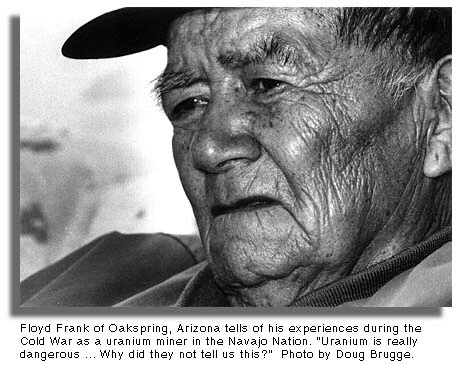Slay the Yellow Monster
Low-grade uranium ore is nicknamed "yellowcake"
for its color and powdered consistency. The Navajo have another name: Leetso, or
"yellow monster."

I came to the American Southwest 20 years ago intending to manage a computer system for the Indian Health Service. That’s another tale. But, I lived in Chinle, AZ, in the heart of the Navajo Nation and witnessed the results, generations on, of DNA damaged by uranium mining.
The Yellow Monster surfaced on the Navajo Nation with uranium mining that started in the 1940s and continued for the next several decades. In its aftermath came illnesses such as lung cancer among mine workers and worries about environmental contamination among people who live on that land.
The Navajos believe you must gain knowledge of a monster to slay it and restore nature’s balance. Northern Arizona University biochemist Diane Stearns and her Navajo students are not only gaining knowledge, they are adding to that knowledge with new discoveries about uranium.
The fact that uranium, as a radioactive metal, can damage DNA is well documented. But what Stearns and her collaborators recently have found is that uranium can also damage DNA as a heavy metal, independent of its radioactive properties.
“Essentially, if you get a heavy metal stuck on DNA, you can get a mutation,” Stearns explained. Other heavy metals are known to bind to DNA, but Stearns and her colleagues are the first to identify this trait with uranium. Their results were published recently in the journals Mutagenesis and Molecular Carcinogenesis.
Their findings have far-reaching implications for people living near abandoned mine tailings in the Four Corners area of the Southwest and for war-torn countries and the military, which uses depleted uranium for anti-tank weapons, tank armor and ammunition rounds. Depleted uranium is what is left over when most of the highly radioactive isotopes of uranium are removed.
Navajo Neuropathy currently affects 1 of every 1600 births in the Navajo Nation. Onset usually is perceived after 1 year. Most folks don’t understand the cruelty of feeling no pain — unless they see a little kid brought into the ER who’s been walking around for a week or two on a broken leg. Because he didn’t know it was broken.
Additional Resource
Posted: Tue - April 11, 2006 at 09:53 AM